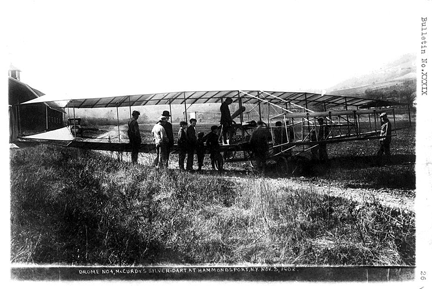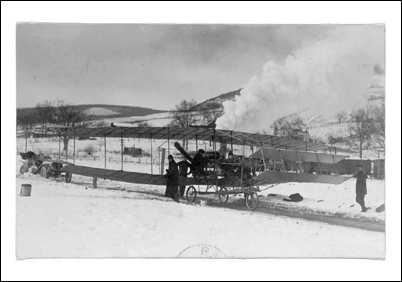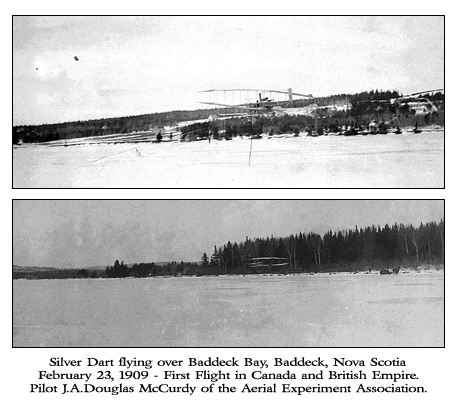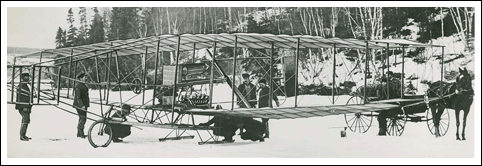The Silver Dart - Aerodrome 4
With the June Bug still intact the members of the Association set about building their final winged Aerodrome.
The lead designer for Aerodrome 4 was Douglas McCurdy. McCurdy had flown several times in the June Bug and Glenn Curtiss, who had the most air time of the AEA members, said that McCurdy had been a very skilful pilot when in the June Bug.1 Curtiss worked closely with McCurdy, but as was the practice with the AEA, the lead designer was in charge of all final decisions over design and construction.
Aerodrome 4 was christened the Silver Dart because of the rubberized silk balloon cloth that was used to cover the wings. The balloon cloth was provided by Capt. Thomas Scott Baldwin who had located his rigid balloon factory at Hammondsport to be close to the Curtiss engine plant. This silver colored fabric was the best covering for the wings of any used by the AEA.2 It was impervious to air penetration and thus maximized the lift generated by the wings when the aircraft was at flight speed.

The Silver Dart, ready for trial flights at Hammondsport NY, November 1908.
The frame and structure of the Silver Dart was made of bamboo with steel tube ferrules, friction tape binding, and wood. The wing struts were hewn from spruce, the individual wing ribs were made of ash. Wire cross bracing gave sturdiness and rigidity to the structure. The engine, supplied by Glenn Curtiss, was a reliable water cooled V-8 that developed 35 hp (26 kW) at 1,000 rpm and up to 50 hp at higher rpm. This was the first water cooled aircraft engine developed by Curtiss. The propeller was carved from a solid block of wood. The tricycle undercarriage, now a standard feature on AEA aircraft, was made of steel tubing using motorcycle wheels from the Curtiss motorcycle factory.
The Silver Dart had a length of 9.15 metres (30 ft. 0 in.), a wingspan of 15.0 metres (49 ft. 1 in.) and an overall height of 2.9 metres (9 ft. 7 in.). These dimensions made the Silver Dart the largest of all the aerodromes produced by the AEA. It was 1.8 metres longer (3 ft. 6 in.) and had a larger wing span by 2.0 metres (6 ft. 7 in.) than its predecessor, the June Bug.
The Silver Dart made several successful flights in Hammondsport. The principal pilot was Douglas McCurdy but Glenn Curtiss also made several flights as he worked to tune the engine to maximum horsepower and thrust. The longest flight in Hammondsport was over a distance of one and one-half miles.3

Since winter weather was approaching, the Silver Dart was disassembled and packed for shipment to Baddeck, Nova Scotia where Dr. Bell was asking for the aircraft attempt the first powered flight of an aircraft in Canada and the British Empire.
The aerodrome was shipped via rail from Hammondsport through Buffalo, NY to the international bridge crossing at Niagara Falls. From there it proceeded by rail to Nova Scotia after a brief incident with import duties at the border. Intervention from the Mayor of Baddeck and the Premier of Nova Scotia led Canadian authorities to vastly reduce the import tariff on the aircraft and it was on its way to a rendezvous with history.
The Silver Dart was reassembled in a temporary shelter on the shores of Baddeck Bay where the mechanics put it together but did not immediately install the Curtiss engine. instead, the engine was mounted in Dr. Bell's Cygnet II kite, an aerodrome like device with a canard elevator system at the front and tetrahedral celled wings.
On February 20 and 21, 1909 several unsuccessful attempts were made to fly the Cygnet II with the Silver Dart's engine. On February 22, 1909 the Curtiss engine was remounted in the Silver Dart in readiness for an attempt at flight off the ice of Baddeck Bay on the following day.
There was such excitement about the impending flight of the Silver Dart, that a school holiday was declared for February 23rd. In addition many businesses closed and several hundred of the Baddeck villagers gathered on the ice to witness the impending flight.
The Silver Dart was rolled out onto the ice on her tricycle carriage. Dr. and Mrs. Bell sat bundled in a horse drawn sleigh anxiously awaiting, along with the assembled crowd, the attempt at flight.

Pointing the Silver Dart into the wind, the engine was started and after a brief taxi the aircraft lifted into the air. McCurdy took the aerodrome up to an altitude of about thirty feet and flew for a distance of about three-quarters of a mile at an estimated speed of forty miles per hour.

The crowd cheered and threw hats and mitts into the air! McCurdy was pleased but wanted to take a second flight to attempt to increase the distance. However, Dr. Bell, mindful of the historic event that had just occured restrained him. Bell said to the assembly gathered around McCurdy: "What we have seen just now may well prove to be one of the really important pages in history, I wouldn't want it to be spoiled. Douglas, you can fly her again tomorrow if you like, but that's all for today."4
Bell then invited everyone to a celebration at Beinn Breagh that Mabel already had the household staff prepare for. Most of the villagers accepted and the festivities lasted into the early evening. Everyone in the village who had witnessed the flight signed a special book that Bell brought out to verify what had occurred. Later, this list was entered into the record of the work of the AEA by being published in one of the volumes of the Bulletin of the Aerial Experiment Association.
McCurdy made the following entry about the event in the weekly edition of the Bulletin:
" The morning of today (February 23) was spent in getting the Silver Dart ready for a trial flight. The transmission was changed from the four V-belt drive to a single chain drive which, it was anticipated, would not only give greater efficiency, but would be of less weight. The gearing used was 18-24 (or 3-4), the engine turning over 24 revolutions to the 18 revolutions of the propellors.
We had three propellers. . . . . The propeller finally decided upon was one having a diameter of seven feet six inches, and a pitch at the tip of 20-22 degrees. This propeller was not one of constant pitch speed.
The Silver Dart was finally taken across the bay on the ice, and a start made at a spot just off Fraser's Pond. In the first trial, a gasoline pipe broke after the machine had travelled about 100 feet.
Upon fixing this, a second start was made, which was very successful. The machine rose from the ice after travelling about 100 feet, and flew at an elevation of about ten to thirty feet directly east for a distance of about half a mile. Landed without any jar whatsoever. The speed I should judge to be about forty miles per hour."5
Dr. Bell arranged for telegraphs to be sent to all the major newspapers in the United States, Canada, Great Britain and France. Many of these papers carried the story in their editions of the following morning.
On February 24, 1909, Douglas McCurdy and the Silver Dart were back on the ice in Baddeck Bay once more. The Silver Dart again rose into the sky and reached an altitude of approximately 60 feet as McCurdy piloted Aerodrome 4 for over four and one-half miles. The Washington Star newspaper reported:
" During this second flight [the first occurring on Feb. 23, 1909], this pioneer pilot of Baddeck flew a straight course of a mile and then made a wide circle to return along the other shore at an elevation of some 50 feet and at 40 miles an hour. It is recorded that when he was making this turn, the people on the opposite shore with their teams did not know what to do when they saw this 'wizard' coming their way, as some of them exclaimed. One man lost his head completely, and drove directly under the machine which went over him like a shot. Other people were running for the beach. But away sped the Silver Dart over teams, over people's heads, over trees and over a large tongue of land.
When making for the lower end of the Bay for his second turn, McCurdy relaized that the space was too narrow. He shut off his power and glided to the ice after having flown 4 1/2 miles. In landing, one of the wings brushed the ice and was slightly damaged, while one of the front wheels was bent."6
The Silver Dart went on to make many more flights in Baddeck. Some of the flights were made when the Silver Dart was fitted with runners in place of the two trailing wheels of the undercarriage. The nose wheel was always left on the aircraft.

Casey Baldwin also flew the Silver Dart on a number of occasions. The aerodrome performed flawlessly for both Baldwin and McCurdy.
On March 10, 1909 McCurdy flew the Silver Dart on a circular course of 35 km (20 mi.) in length.
McCurdy's skill as a pilot grew as he logged more and more time at the controls. Curtiss wrote in The Curtiss Aviation Book, that McCurdy reported to him that he made over two hundred flights in the Silver Dart and covered more than a thousand miles.7
After the dissolution of the Aerial Experiment Association on March 31, 1909, McCurdy and Baldwin worked to interest the Canadian Army to consider aerodromes as essential tools for military work.
The Silver Dart was taken to Camp Petawawa in Ontario in July of 1909. While at Petawawa, on August 2, 1909, the historic aircraft became the first in Canada to carry a passenger on a flight. It finally wrecked at Petawawa on August 3, 1909 as it made a hard landing striking a small sandy dune. It was deemed to be unrepairable. The Canadian Army declined to place any orders for aerodromes with McCurdy and Baldwin.
Today, a cairn, erected in August of 1952 marks the spot at Canadian Forces Base Petawawa where the Silver Dart carried out trial flights for the Army.
______________
In 2009, celebrations of the Centennial of Flight in Canada were held at Baddeck, Nova Scotia on Feb. 23, 2009. This large celberation featured the flight of a true to original replica constructed from the original plans for the 1908-9 Silver Dart by a group of volunteers from the Welland Ontario area of Canada. The story of the Silver Dart replica constructed by the AEA 2005 Inc. group is well worth reading.
Additional reports about the Silver Dart can be read at:
- Silver Dart Replica Flies to Honour a Century of Aviation in Canada
- Silver Dart Replica Flies Into History Books.
The Silver Dart Replica built in Welland, Ontario by the AEA 2005 Inc. group was transported to Baddeck, Nova Scotia for an historic 100th anniversary flight. On February 22, 2009, the eve of the 100th anniversary of the original Silver Dart's flight, the replica took to the air bringing history back to life. View the flight on YouTube.
______________
Notes:
- Curtiss, Glenn H., and Augustus Post. The Curtiss Aviation Book. p.45.
- Green, H. Gordon. The Silver Dart. p.58. McCurdy stated: "Baldwin was with the Goodyear people and his preparation for plane wings was a silver-coloured rubber compound. It worked admirably."
- Green, H. Gordon. The Silver Dart. p.58.
- Green, H. Gordon. The Silver Dart. p.60.
- Green, H. Gordon. The Silver Dart. p.61.
- Green, H. Gordon. The Silver Dart. p.63-64.
- Curtiss, Glenn H., and Augustus Post. The Curtiss Aviation Book. p.56.
References:
- Curtiss, Glenn H., and Augustus Post. The Curtiss Aviation Book. New York: Frederick A. Stokes Company, 1912.
- Gray, Charlotte. Reluctant genius Alexander Graham Bell and the passion for invention. 1st ed. ed. New York: Harper Collins, 2006. 1-477.
- Gray, Charlotte. "First Flight." The Beaver Canada's History magazine Vol. 89 (Feb-Mar 2009): 14-22.
- Green, H. Gordon. The Silver Dart. 1st ed. Fredricton, N.B.: Brunswick P Ltd., 1959. 1-208.
- Grosvenor, Gilbert M. "Canada's Winged Victory: the Silver Dart." The National Geographic Magazine Aug. 1959: 254-67.
- "Mabel Bell and the Aerial Experiment Association." Inventors: Profiles in Canadian Genius. Comp. Thomas Carpenter. Camden, ON, Canada: Camden House, 1959.
- Parkin, J. H. Bell and Baldwin: Their Development of Aerodromes and Hydrodromes at Baddeck, Nova Scotia. 1st ed. ed. Toronto, Canada: University of Toronto P, 1964. 1-555.
- "Silver Dart Makes Aviation History." CBC Digital Archives - The Silver Dart. 23 Feb. 1949. Canadian Broadcasting Corporation. 10 Nov. 2008 <http://archives.cbc.ca/science_technology/aeronautics/clips/2424/>.
- Toward, Lilias M. Mabel Bell : Alexander's Silent Partner. New York: Breton Books, 1996.
- Vincent, Mary. "Our Passion for Flight: From the Silver Dart to the Snowbirds - How Aviation Connected Canada." Canadian Geographic (2000): 46-55.September-October Issue, 2000.
Note: Photos of the Silver Dart are from the Bulletin of the Aerial Experiment Association, courtesy of the Glenn H. Curtiss Museum. No further publication or distribution is authorized without the expressed permission of the Museum.




